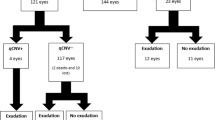Abstract
Purpose: To determine the role of indocyanine green angiogaphy (ICGA) in the prediction of the development of choroidal neovascularization (CNV). Methods: We reviewed the ICG angiograms of 124 patients with newly diagnosed unilateral occult CNV secondary to age-related macular degeneration (AMD) in whom the fellow eye had only drusen by biomicroscopy and fluorescein angiography. Follow-up data of at least 12 months were obtained in all eyes. Results: 113 fellow eyes had a normal ICG study, while 11 fellow eyes revealed plaque-like late hyperfluorescence. During an average follow-up time of 18.2 months exudative AMD developed in 7 of 11 eyes with late hyperfluorescence on ICGA and in 6 of 113 with a normal ICGA study. Conclusion: ICGA may help to predict which fellow eyes are at higher risk of developing future exudative changes.
Similar content being viewed by others
References
Leibowitz H, Krueger DE, Maunder LR. The Framingham Eye Study monograph: an ophthalmological and epidemiologic study of cataract, glaucoma, diabetic retinopathy, macular degeneration, and visual acuity in a general population of 2631 adults of 1973–1975. Surv Ophthalmol (Suppl) 1980; 24: 335–610.
Hyman LG, Lilienfeld AM, Ferris FL III, Fine SL. Senile macular degeneration. A case control study. Am J Epidemiol 1983; 118: 213–27.
Ferris FL, Fine SL, Hyman L. Age-related macular degeneration and blindness due to neovascular maculopathy. Arch Ophthalmol 1984; 102: 1640–2.
Sarks SH, VanDriel D, Maxwell L, Killingsworth M. Softening of drusen and subretinal neovascularization. Trans Ophthalmol Soc UK 1980; 100: 414–22.
Smiddy WE, Fine SL. Prognosis of patients with bilateral macular drusen. Ophthalmology 1984; 91: 271–7.
Bressler NM, Bressler SB, Seddon JM. Drusen characteristics in patients with exudative versus non-exucative age-related macular degeneration. Retina 1988; 8: 109–14.
Pauleikhoff D, Barondes MJ, Minassian D, Chisholm IH, Bird AC. Drusen as a risk factor in age-related macular decrease. Am J Ophthalmol 1990; 109: 38–43.
Holz FG, Wolfensberger TJ, Piguet B, Gross-Jendrsoska M, Wells J, Minassian DC, Chisholm IH, Bird AC. Bilateral macular drusen in age-related macular degeneration. Ophthalmology 1994; 101: 1522–8.
Sarks SH. Council Lecture: Drusen and their relationship to senile macular degeneration. Aust J Ophthalmol 1980; 8: 117–130.
Sarks JP, Sarks SH, Killingsworth MC. Evolution of soft drusen in age-related macular degeneration. Eye 1994; 8: 269–83.
Green WR, Key SN. Senile macular degeneration: a histopathological study. Trans Am Ophthalmol 1977; LXXV: 180–254.
Green WR, McDonnell PJ, Yeo JH. Pathologic features of senile macular degeneration. Ophthalmology 1985; 92: 615–27.
Green WR, Enger C. Age-related macular degeneration histopathologic studies. The 1992 Lorenz E Zimmerman lecture. Ophthalmology 1993; 100: 1519–35.
Archer D, Krill AF, Newell FW. Fluorescein study of normal choroidal circulation. Am J Ophthalmol 1970; 69: 543–54.
Cherrik GR, Stein SW, Levy CM. Indocyanine green: observation on its physical properties, plasma decay and hepatic extraction. Clin Invest 1960; 539: 592.
Yannuzzi LA, Slakter JS, Sorenson JA, Guyer DR, Orlock DR. Digital indocyanine green videoangiography and choroidal neovascularization. Retina 1992; 12: 191–223.
Scheider A, Kaboth A, Neuhauser L. Detection of subretinal membranes with indocyanine green and an infrared scanning laser ophthalmoscope. Am J Ophthalmol 1992; 113: 45–51.
Regillo CD, Benson WE, Maquire JI, Annesley WH. INdocyanine green angiography and occult choroidal neovascularization. Ophthalmology 1994; 101: 280–8.
Guyer DR, Yannuzzi LA, Slakter JS, Sorenson JA, Hope-Ross M, Orlock DR. Digital indocyanine green videoangiography of occult choroidal neovascularization. Ophthalmology 1994; 101: 1727–37.
Macular Phtocoagulation Study Group. Sobfoveal neovascular lesions in age-related macular degeneration. Guidelines for evaluation and treatment in the Macular Photocoagulation Study. Arch Ophthalmol 1991; 109: 1242–57.
Yannuzzi LA, Hope-Ross M, Slakter JS, Guyer DR et al. Digital indocyanine green videoangiography and vascularized pigment epithelium detachment. Retina 1994; 14: 99–113.
Sorenson JA, Yannuzzi LA, Slakter S, Guyer DR, Orlock D. A pilot study of indocyanine green videoangiography-guided laser treatment of recurrent choroidal neovascularization in age-related macular degeneration. Arch Ophthalmol 1994; 112: 473–9.
Chang TS, Freund KB, De la Cruz Z, Yannuzzi LA, Green WR. Clinicopathologic correlation of choroidal neovascularization demonstrated by indocyanine green angiography in a patient with retention of good vision for almost four years. Retina 1994; 14: 114–24.
Killingsworth MC. Angiogenesis is early choroidal neovascularization secondary to age-related macular degeneration. Graefe's Arch Clin Exp Ophthalmol 1995; 233: 313–23.
Gregor Z, Bird AC, Chisholm IH. Senile disciform macular degeneration in the second eye. Br J Ophthalmol 1977; 61: 141–7.
Strahlman ER, Fine SL, Hillis A. The second eye of patients with senilemacular degeneration. Arch Ophthalmol 1983; 101: 1191–3.
Bressler SB, Maguire MG, Bressler NM, Fine SL, Macular Photocoagulation Study Group. Relationship of drusen and abnormalities of the RPE to the prognosis of neovascular macular degeneration. Arch Ophthalmol 1990; 108: 1442–7.
Author information
Authors and Affiliations
Rights and permissions
About this article
Cite this article
Schneider, U., Gelisken, F., Inhoffen, W. et al. Indocyanine green angiographic findings in fellow eyes of patients with unilateral occult neovascular age-related macular degeneration. Int Ophthalmol 21, 79–85 (1997). https://doi.org/10.1023/A:1005848806641
Issue Date:
DOI: https://doi.org/10.1023/A:1005848806641




